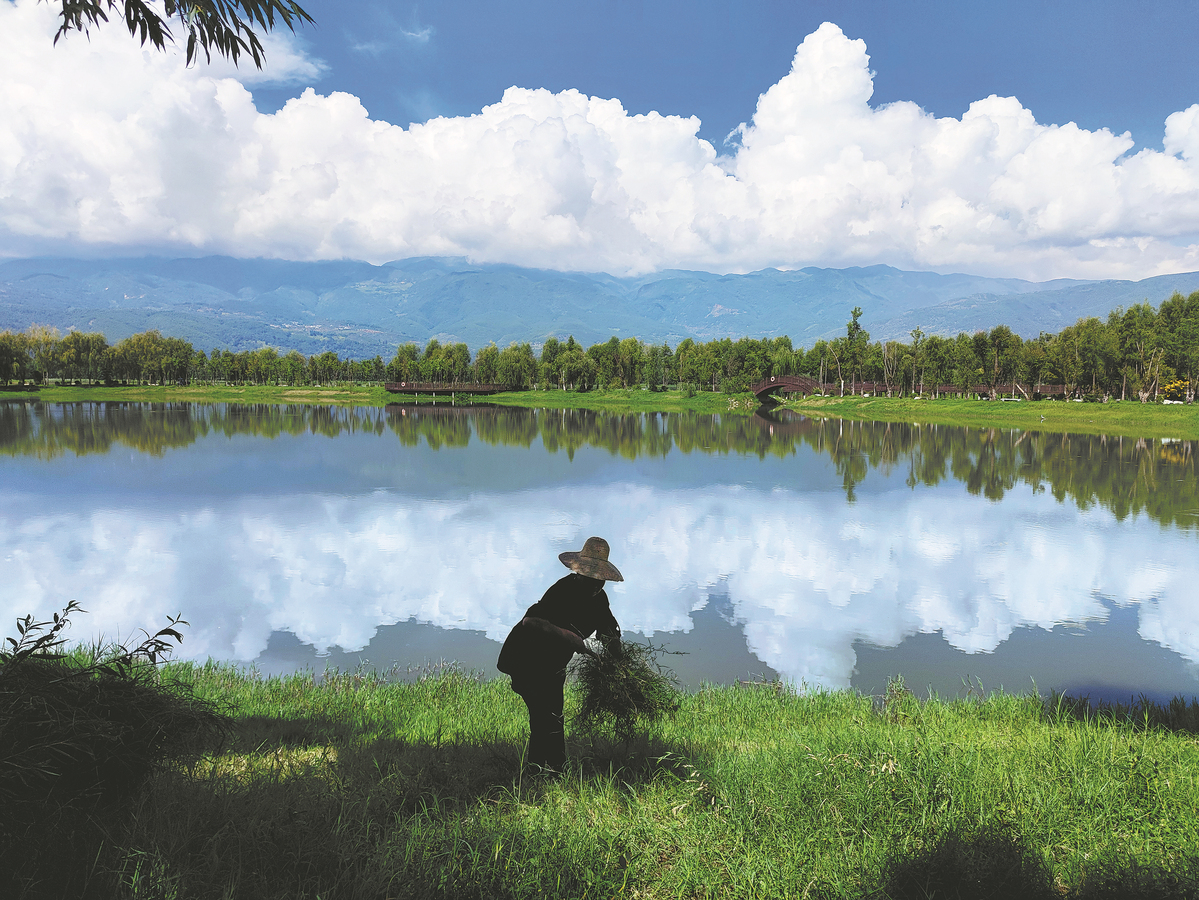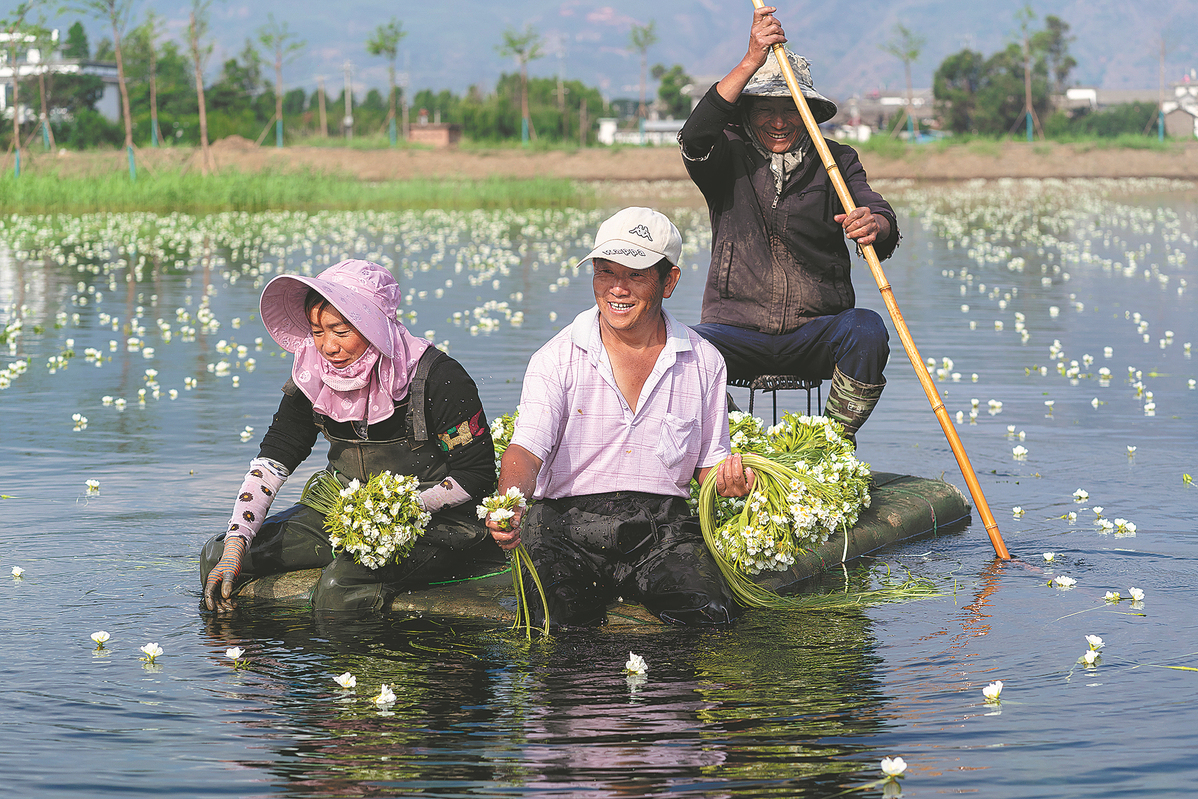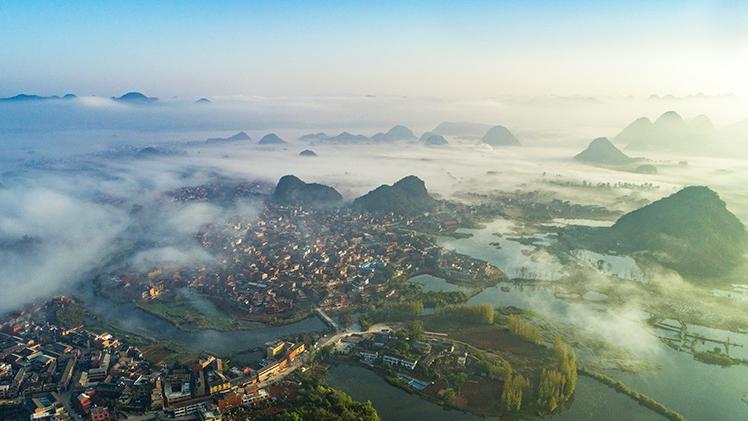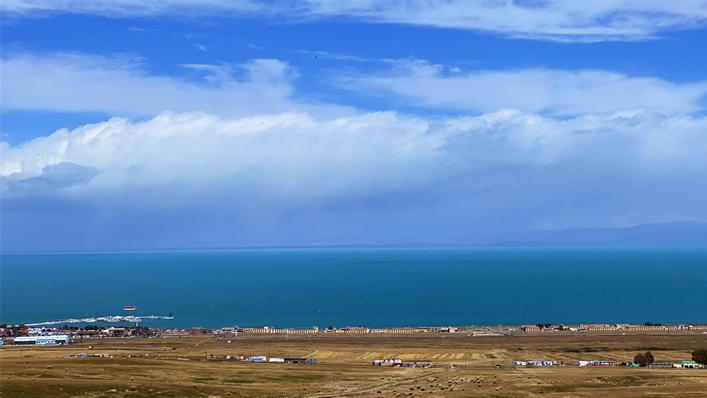Green shift provides lifeline for Yunnan's lakes

A farmer cleans out weeds from a wetland area in Eryuan county, Yunnan province, last month. The county is named for being the source of Erhai Lake. (PENG CHAO/CHINA DAILY)
The nine lakes that dot the plateau in Yunnan province, Southwest China, that provide a crucial ecological barrier and water conservation area in the upper reaches of the Yangtze River, have been pulled back from the brink of environmental disaster due to years of rapid industrialization and urbanization.
Many of the lakes, each covering more than 30 square kilometers, had suffered from years of industrial and agriculture runoff, with even raw sewage making its way into their waters as China embraced high-speed economic development from the 1980s.
Dianchi Lake — the largest freshwater lake in Yunnan — became one of China's most polluted lakes in the 1990s with its water quality falling below Grade V, the lowest water quality in the national five-tier grading system for surface water.
"Various types of garbage and large quantities of blue-green algae were floating on the water surface. The water turned murky and gave off a strong foul smell. Many fish died," recalled Li Yunli, a 60-year-old local who grew up by the lake.
"This really broke our hearts since we had lived by the lake for generations," she said.
Erhai Lake, the second largest lake in Yunnan and a popular scenic spot, suffered a near-fatal blow to its ecosystem at that time with farms, real estate projects, and hotels releasing too many pollutants into the water.
"The nine lakes are all located on the Yunnan-Guizhou Plateau. Compared with other water bodies, plateau lakes are relatively isolated and their water replacement period is longer, which means that they lack the ability for effective self-purification," said Liu Xiaoyong, deputy director of the development research center of the Ministry of Water Resources.
"Plateau lakes also have relatively fewer species and their ecosystems are fragile. Once damaged, it can be very difficult to restore them," he said.
In order to save these lakes, government departments, institutions, and local residents have worked together and taken a series of actions, exploring a greener development path for harmonious coexistence between humans and nature.

Farmers harvest haicai (Ottelia acuminata) in Eryuan in June. The edible plant is very sensitive to changes in water quality, making it a barometer of the lake's health. (LUO XINCAI/XINHUA)
Restoration efforts
From the early 2000s, to ease the pressure on these lakes caused by population concentration and excessive development, Yunnan formulated special regulations to guide the gradual withdrawal of the population and industries from lakeside areas.
Since 2008, Kunming, the provincial capital, has been clearing farmland, fish ponds, and structures within 200 meters of Dianchi's shoreline. A total of 58 wetlands covering 3,047 hectares have been restored.
In 2018, the city of Dali completed the demolition of 1,806 households and homestays on the shores of Erhai Lake. The shoreline was then transformed into an ecological corridor to intercept and purify polluted water and reduce the impact of human activities.
"An important measure to manage and protect the lake is to control pollution at the source," said Yuan Tingju, director of Kunming's Dianchi Lake administration bureau.
Yuan said the city has implemented a project to separate rainwater and sewage, which includes the construction and reconstruction of over 200 km of drainage pipes. It has also built 29 urban sewage and rainwater treatment plants in the Dianchi Lake basin, with an annual sewage treatment capacity of 700 million cubic meters.
"To accelerate the lake's water circulation, we have been diverting water from the Niulan River and only discharging high-standard purified wastewater from treatment plants," he said.
A total of 1.06 billion cubic meters of water from the Niulan River and 1.82 billion cubic meters of purified wastewater have been discharged into the lake, which is the equivalent of replacing all the water in Dianchi twice, he added.
Xiong Hua, deputy director of the Kunming Dianchi National Tourism Resort's water management bureau, said rainwater from the drainage network, river water, and purified wastewater stay in the wetlands for five to seven days before entering the lake.
"This process further reduces pollutants and breaks down excess nutrients, to ensure the quality of the water that flows into the lake," he said.
Similar measures have also been taken in the Erhai Lake basin.
Eryuan county, the main water source for Erhai Lake, has preserved 2,013 hectares of natural wetlands and created 2,573 hectares of artificial wetlands, said Yang Chunbing, director of the county's wetland protection and management center.
"Tests conducted by professional agencies show that the wetland purification process can improve water quality from Grade IV to Grade III or even Grade II," he said.
A total of 25 livestock and poultry manure collection stations have been built in the basin. The local government provides a subsidy of 80 yuan ($11.2) per metric ton to enterprises that collect and turn organic waste into fertilizer or biogas.
Liu Fei, executive deputy general manager of Yunnan Shunfeng Erhai Environmental Technology Co, said his company collects nearly 2,000 tons of organic waste every day from the basin, and transforms it into organic fertilizers and biogas.
Species revival
The province's efforts to clean up the lakes are starting to pay off.
Since 2018, the water quality in Dianchi Lake has stabilized at Grade IV, while that of Erhai Lake fluctuates between Grade II and Grade III, data from the authorities show.
Statistics from Kunming's ecology and environment bureau show that vegetation coverage in the wetlands around Dianchi has increased from 13.1 percent in 2007 to 81 percent. The number of bird species spotted in the area during the same period has risen from 89 to 175.
Li Yunli, who used to be a fisherwoman, said that she's noticed many fish species that had disappeared from the lake long ago have returned.
One of them is the golden-line barbel, an endangered fish species that had been absent from the lake since the 1980s.
Wang Xiaoai, a senior engineer at the Chinese Academy of Sciences' Kunming Institute of Zoology, said since 2009, the institute has released over 3 million artificially bred golden-line barbels into the Dianchi Lake basin.
"According to our monitoring, these fish have formed a stable adult population of 400 to 500 for a decade in the Panlong River, a major river that flows into Dianchi Lake," she said.
Yang Chunbing, director of Eryuan's wetland protection and management bureau, said many rare bird species have returned to the county's wetlands for winter.
"Last year, national first- and second-class protected birds — the oriental white stork, the black stork, the glossy ibis and the greylag goose — were found wintering here for the first time," he said.
Yang said the improved water quality has provided the foundation for large-scale plantation of Ottelia acuminata, an edible aquatic plant endemic to Southwest China.
"Planting Ottelia acuminata in the wetlands will not only help absorb and eliminate harmful pollutants in the water such as nitrogen and phosphorus, but also generate economic benefits," he said, noting that it will promote the coordinated development of wetland conservation and the local economy.
Duan Conggui, an environmental protection engineer in charge of the Eryuan Ottelia acuminata industry research base, said the plant cannot survive in water that is not clean enough or even slightly polluted, which makes it an eco-friendly food.
"The Ottelia acuminata offers greater economic benefits than common crops like corn and rice," said Rui Longjia, Party chief of Songqu village in Eryuan. "Its cultivation, weeding, and harvesting can create many job opportunities as these processes all rely on manual labor."
According to Eryuan's development plan for its Ottelia acuminata industry, the planting area of the aquatic plant will reach 1,333 hectares by 2028, generating an output value of 600 million yuan. Farmers involved in the industry are expected to have an average annual income of over 40,000 yuan.
Eco-tourism circle
The Dianchi and Erhai lakes have seen a resurgence in tourism thanks to the significant improvement in their ecological environment.
Miao Ruiqi, who works at the company that built the Erhai Ecological Corridor project, said that this summer, a peak average of about 120,000 tourists visited the corridor each day.
"Cycling along the ecological corridor has become a popular thing to do and has been promoted heavily online," he said.
Kunming Dianchi National Tourism Resort received 23.68 million visits last year, generating a revenue of 26.2 billion yuan, an increase of 45.58 percent year-on-year, said Yang Peng, chief economist at the resort.
Yang said the emphasis of development around Dianchi used to be real estate and commercial industries, but now the focus has shifted to more eco-friendly industries such as tourism, culture, sports, wellness, and health.
Ren Xizhong, deputy director of Kunming's agriculture and rural affairs bureau, said the local government launched a project in February last year to transform and upgrade villages around the lake, aiming to realize rural vitalization through the development of eco-tourism.
"We are developing 46 villages based on their own unique historical and cultural characteristics to create a diverse, well-equipped, and distinctive rural eco-tourism circle," he said.
Haiyan, a 600-year-old fishing village, has become an "internet famous" destination for tourists to capture what is touted as "the most beautiful sunset".
Li Tie, Party chief of the working committee of the Dayu subdistrict, said the village is already home to more than 100 businesses, including restaurants, homestays, coffee shops, and art studios. These businesses have created more than 300 jobs that pay an average salary of more than 3,000 yuan per month.
Around 98 households in the village rent out their houses, increasing their annual income by an average of more than 100,000 yuan, he said.
Local Xiao Yuan quit her job at a real estate company and joined her mother in running their own store that mainly sells a pea flour dish, which is a specialty in Yunnan.
"We sell about 100 bowls a day on weekdays. On weekends and holidays we can sell up to 300 bowls a day," Xiao said, adding that a bowl sells for 8 yuan.
Yang Ran contributed to this story.
Photos
Related Stories
- Picturesque sceneries of karst wetlands in SW China's Yunnan
- Ethnic unity promotes development of industries in SW China's Yunnan
- China makes great achievements in environmental protection over past 75 years
- Century-old pomegranate trees in SW China's Yunnan well protected, yield juicy, sweet fruits
- Coffee shops in SW China's Yunnan help individuals with special needs integrate into society
Copyright © 2024 People's Daily Online. All Rights Reserved.









